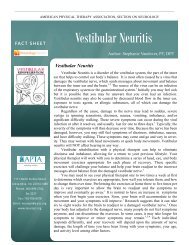Practice Guidelines for BPPV - Neurology Section
Practice Guidelines for BPPV - Neurology Section
Practice Guidelines for BPPV - Neurology Section
You also want an ePaper? Increase the reach of your titles
YUMPU automatically turns print PDFs into web optimized ePapers that Google loves.
Vestibular SIG Newsletter <strong>BPPV</strong> Special Edition<br />
Children (usually with associated migraine) to older adults can develop <strong>BPPV</strong>, with the incidence of <strong>BPPV</strong> increasing<br />
with increasing age. 6,7 As the US population “greys”, the incidence of <strong>BPPV</strong> will most likely increase. Patient education<br />
and proper management of <strong>BPPV</strong> is key to the patients’ recovery, especially in older adults. There is now compelling<br />
evidence that reports of falls and dizziness are related. 8 Fear of falling and the return of “normal balance” <strong>for</strong> the patient<br />
with <strong>BPPV</strong> is a key element that must be addressed after the <strong>BPPV</strong> has resolved. 9-16 People who have experienced <strong>BPPV</strong><br />
deserve quality patient education in order to minimize their fear of recurrence plus fear of falling in order to improve their<br />
quality of life.<br />
The goal of this newsletter is to provide an update on some of the newest interventions and data that apply to <strong>BPPV</strong>. We<br />
hope that some of this evidence will influence your practice and improve the care that your patients receive.<br />
Susan L. Whitney, Vestibular SIG Chair<br />
Reference List on Page 11<br />
quality as Grade C due to the lack of randomized controlled<br />
trials. This recommendation was accompanied by the same<br />
patient exclusions as described <strong>for</strong> the Dix-Hallpike test,<br />
which were previously described in this article.<br />
Message from the Chair<br />
By Susan Whitney (Continued from page 1)<br />
Due to the orientation of the posterior canal in relation to the<br />
horizontal canals, the CRP maneuver described <strong>for</strong> treating<br />
posterior canal <strong>BPPV</strong> is ineffective <strong>for</strong> treating horizontal<br />
canal <strong>BPPV</strong>. The roll maneuver (Lempert maneuver or<br />
barbecue roll) is the most frequently described treatment <strong>for</strong><br />
horizontal canal <strong>BPPV</strong>. This maneuver involves rolling the<br />
patient 360 degrees with 90 degrees of movement at a time to<br />
eliminate the otoconia from the horizontal canal. The only<br />
research identified by both groups that examined the<br />
effectiveness of this maneuver were Class IV studies which<br />
showed success rates ranging from 50% to close to 100%.<br />
However due to the lack of higher-level evidence, both<br />
groups commented that this treatment was likely effective<br />
but were unable to recommend it. The AAN also<br />
<strong>Practice</strong> <strong>Guidelines</strong> <strong>for</strong> <strong>BPPV</strong><br />
By Heather Dillon (Continued from page 2)<br />
8<br />
commented on additional treatments used to treat<br />
horizontal <strong>BPPV</strong> including <strong>for</strong>ced prolonged<br />
positioning, the Gufoni maneuver, the Vannucchi-<br />
Asprella liberatory maneuver, as well as maneuvers<br />
described by Casani et al. and Appiani et al. Level IV<br />
research has described many of these techniques to be<br />
effective. However due to the lack of higher level<br />
research behind them, official practice<br />
recommendations were not made <strong>for</strong> these techniques.<br />
Similarly, the AAN did mention treating anterior canal<br />
<strong>BPPV</strong> but again, the amount and quality of evidence<br />
indentified was insufficient to warrant any<br />
recommendations.<br />
Following treatment of <strong>BPPV</strong> in any canal, many<br />
clinicians provide patients with post-maneuver<br />
guidelines that include activity restrictions. These<br />
instructions range from wearing a cervical collar to<br />
sleeping positions and typically vary between

















